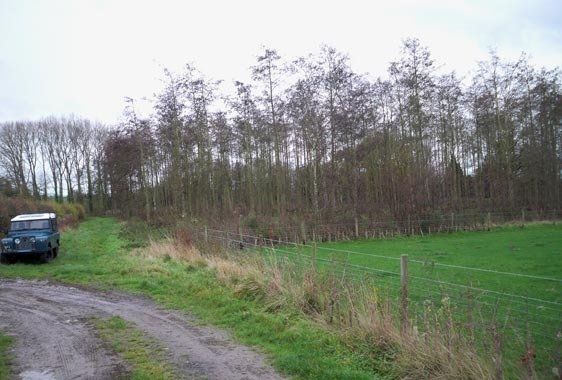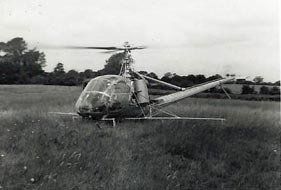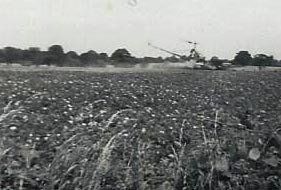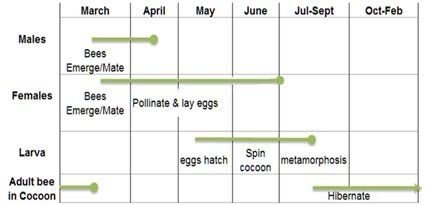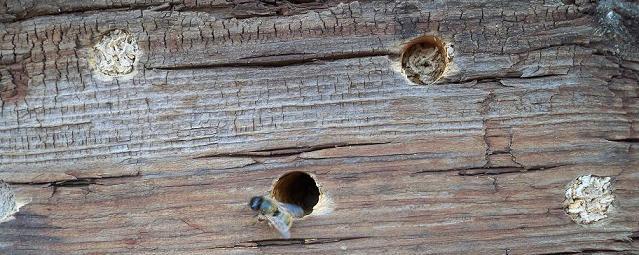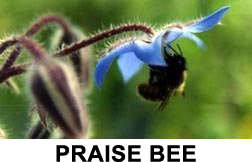Praise Bee Charity Trustees

Our Sponsors
Veolia and Shropshire Council Envirogrant
On 4th March, 2025, we were again delighted to receive a £1,000 grant towards a portable restroom and loo at our new research reserve. This kind donation, like the Wynn Fountation grant, is hugely appreciated.
Viv Marsh (centre) is pictured below with Steve Mitchell, Veolia Regional Director (left) and Gavin Waite, Shropshire Council’s waste contracts manager (right).

Wynn Foundation
In October 2024, we were absolutely delighted to receive a £1,000 grant from the Wynn Foundation, towards our fund to install a new roadway and car park plus mobile hospitality unit at our research reserve. This will allow us to host visiting students from our new college and university wild flower forum that we are setting up to combat the pollinator crisis.
Our warmest thanks go to Dr. Graham Wynn OBE DL and his wife Jenny Wynn OBE DL, vice Lord-Lieutenant of Shropshire, co-founders of the trust that helps county charitable causes.

TVS Supply Chain Solutions
June 2024: We are delighted to have as our latest sponsors TVS - major suppliers to the Ministry of Defence. We look forward to working with them very closely in the future.


CAE UK plc
In March 2019, we were absolutely delighted to receive a most generous sponsorship donation from this worldwide company. CAE UK plc is a key supplier to the UK Ministry of Defence, providing a range of synthetic training equipment and training services.

Kuehne + Nagel Ltd
Kuehne + Nagel Group is one of the world's leading logistics companies who kindly made a generous donation to the charity in April 2019.

Babcock
Babcock is a leading provider of critical, complex engineering services which support national defence, save lives and protect communities. Babcock have also made a most generous donation in June 2019.

St. Stephen's PCC
Completely out of the blue, we were delighted to receive a donation from St. Stephen's Parochial Church Council. The funds have now been used to purchase additional bee nests.
Latest news
Welcome to our latest Trustee
We are delighted to welcome Ralph Early to our board of trustees. Ralph is a food scientist and food ethicist, He was Professor of Food Industry in Harper Adams University, head of the department of Food Science and Agri-food Supply Chain Management and director of the West Midlands Regional Food Academy.
Ralph retired in December 2018 after 25 years in the university sector. Before this he spent 20 years in the food industry, gaining experience in farming, food manufacture, product development, and quality and food safety management, including as Head of Industrial Products Development and then as Quality Standards Manager for Dairy Crest Ltd. A Trustee and Council Member of the Food Ethics Council, he is also an independent member of the Telford and Wrekin Climate Change Partnership.
Pollen profiling
This research is now making progress, as we master the art of photographing pollen collected from last year's bee nests. This will eventually allow us to identify which species of wild flowers the Red Mason bee prefers. It's our belief that these bees have particular favourite choices and this research will soon be part of a bigger picture, looking at nectar selection as well. We will announce details of this and other research in the near future.
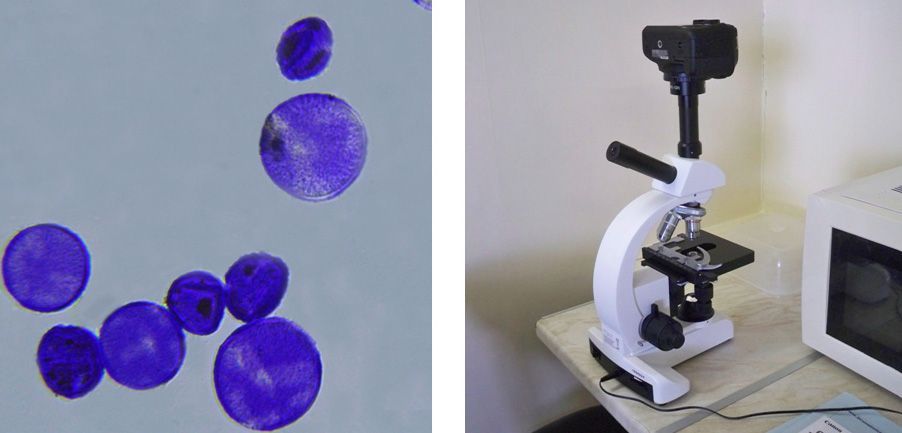
2024 Defence Estate bee breeding results
Despite the rather inclement wet weather that has pushed down the number of bees bred, we still had some good results for the Ministry of Defence. In particular, we have discovered a large colony of Orange-vented Mason bees (Osmia leaiana) breeding at Defence Munitions (DM) Kineton. These bees are not endangered, but they are not widespread across the UK, so the pupae have now been redeployed across the Defence Estate. Osmia leaiana can take up to two years to emerge, so the effect of this initiative will be a slow response.
Additionally, the first of our 3-year trial of different sized paper bee tubes is showing promising results. We have found that the 10mm and 12mm tubes are proving popular with the leafcutter (Megachile) species.

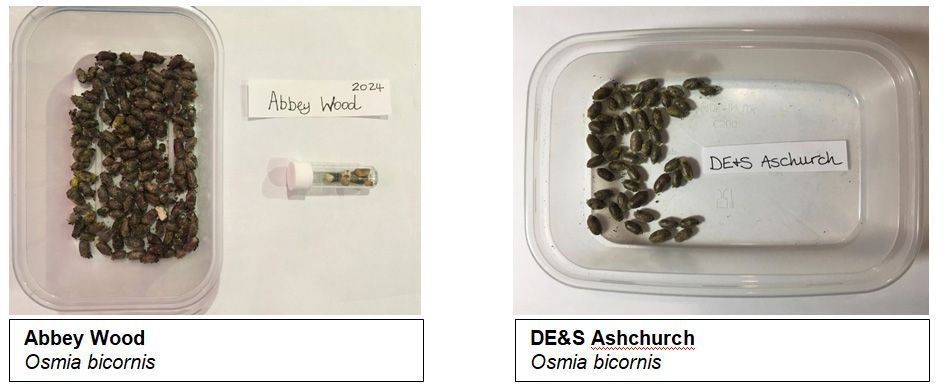
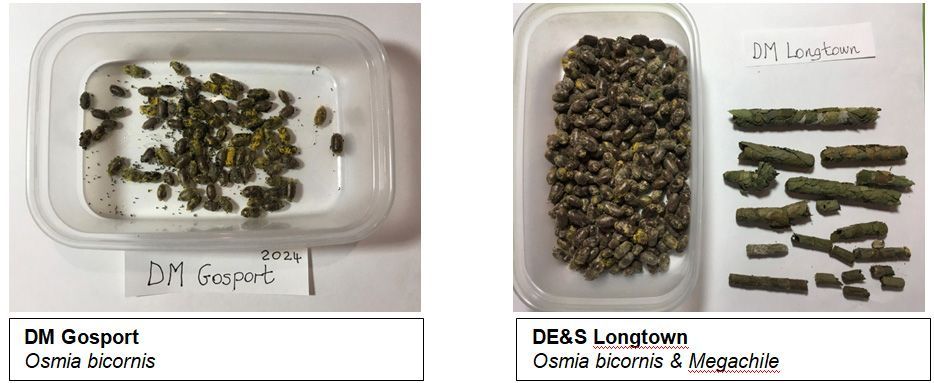
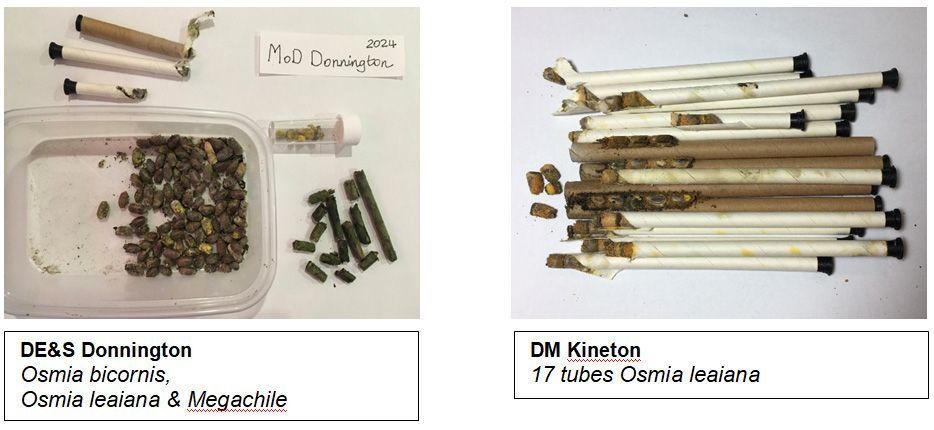
RSPB at Lake Vyrnwy
The trustees are delighted to announce a new working partnership with the RSPB at Lake Vyrnwy. On 23rd May 2024, we installed 6 new empty bee nests (in the locations shown on the map below) across the valley and up to the hotel, to see what species of solitary bees are living there naturally. For some time now, we have been looking for an area that is free from modern agricultural practices, replicating what the environment was like back in the ‘30s, when insect, bird and general wildlife flourished more than it does today. The Vyrnwy Estate is one such rare example that offers the visitor scenery and an air of calmness.

The Countess of Chester Hospital
On 13th May, 2024 we released 2,000 Red mason bees (Osmia bicornis) onto the 100 acre estate of the Countess of Chester Hospital. These bees will then disperse naturally across the Chester area. Below are Jenna Hughes (Assistant Facilities Manager) and Graham Pemberton (Facilities Compliance & Analytics Officer).

DE&S Bicester
On 18th September, 2023, with the help of the Land Rover Discovery dragging the harrows across the seed bed, Lee Sanderson and Viv Marsh sowed a wild flower meadow on Site C. This was not a prescription mix of wild flowers, but a hybrid version that will be used in our forthcoming pollen and nectar profiling of these bespoke wild flowers.

Volunteer RAF Trainees October 2023
On 25th October, 2023 we again hosted a new cadre of 17 RAF Shawbury trainees to help plant the next tranche of wild flowers in our research meadow. Blessed with good weather and under the watchful eyes of Sergeant Andy Ford and Corporals Walker and Quiney we planted an increased number of flowers over last year, which was a terrific achievement as the heavy clay soil was absolutely sodden to walk on. Colonel (Rtd.) Mark Cuthbert-Brown CBE from the County Lieutenancy office and Professor Keith Walters, from Harper Adams University were most impressed with what was achieved.
As a conclusive overview, we can now start to see the fruits of our labours in this research site. As we increase the number of solitary bee species collected from the MoD Defence Estate, alongside these new wild flower species, we now witness greater bee activity. In 2022, we bred over 1,000 pupae of the Red Mason bee, which were relocated to the Queen Elizabeth Hospital in central Birmingham. In 2023 we have now raised over 2,000 pupae, which means that we can release a further 1,000 pupae at the Countess of Chester Hospital plus another 1,000 at another Health Trust hospital, yet to be confirmed.
The picture below to the left shows the trainees building a temporary 'Bailey Bridge' for us to gain access to the 3 acre trials field, alongside the wooded area.
Photo (c) MoD Copyright 2023

Royal Horticultural Society Estate
September 2023 now heralds the finish of our research work at the many RHS gardens in the UK. Having discovered that Wisley, Harlow Carr, Bridgewater and Rosemoor were devoid of the two assumed common solitary bees, namely the Red mason and leafcutter bees, we have now set up new colonies on all these sites. One would expect these properties to have literally been crawling with solitary bees but alas, after putting out empty bee nests in 2021 and 2022, we found that there was no uptake. This isn’t hard scientific proof as there could well have been bees on the furthermost perimeters, but the indications are that this is not the case.
New bee colonies have now been established from stock bred here at Hunkington Nurseries, originating from an amalgam of NHS, Church, MoD sites and Police stations. The RHS are now more than fully capable to continue this research with these and other species of bees and we look forward to reading about their progress – we wish them all the very best in their future endeavours.
Queen Elizabeth Hospital, Birmingham
On 20th April, 2023 we successfully deployed another 1,500 Mason bee pupae for emergence and dispersal into the surrounding suburbs of Harborne in Birmingham, from the Queen Elizabeth Hospital.
Pictured below is Patrick Innis, Project Team Estates Monitoring Officer, overseeing the nest installation on the hospital perimeter fence. All of the pupae were screened and cleaned of any natural parasites/predators to this species of bee.
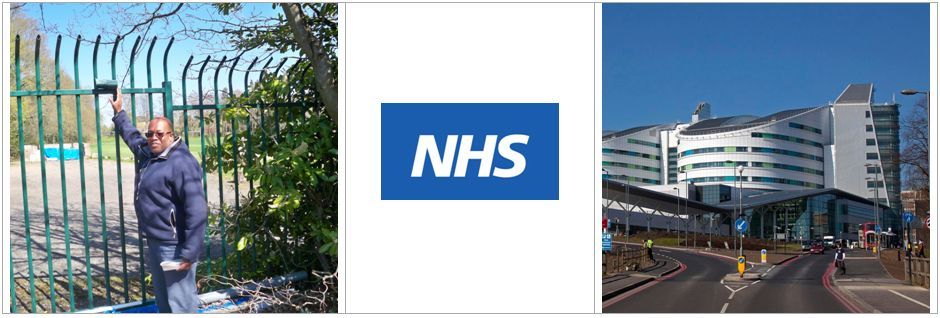
RAF Syerston
In 2022, the MoD sponsored the Praise Bee Charity to establish wild flower meadows over the Defence Estate. In Autumn 2022, a one-acre site was sown at RAF Syerston. This work was carried out by the site’s contractors, Tivoli Services, free of charge. We are most grateful for their support and we hope that this will serve as a shining example for other service companies to support environmental projects across the Defence Estate.
One year later, the photographs below show the results.

Photographs courtesy of Richard Coy, Tivoli Services
Latest predator discovery
Megatoma undata (Carpet beetle)
Whilst cleaning out one of our larger bee stations this year, we discovered some larvae of the Carpet Beetle.
We subsequently found some adult beetles in the cardboard tubes after which had broken down the mud walls and consumed a large number of live bee pupae.

New discoveries


The John Radcliffe Hospital, Oxford
We are delighted to announce that on 8th April, 2022 we released a further 1,000 Red Mason bees from the hospital grounds that will now disperse into the city of Oxford.

Southmead Hospital, Bristol
From the pre-COVID news below, building on the success a few years ago releasing 1,000 Red mason bees across the county of Shropshire, we are now starting a nationwide campaign over the next ten years to repeat this operation across certain key NHS Hospital sites. On Wednesday 16th March, 2022 this operation was repeated at Southmead Hospital, where a further 1,000 bees have been released to colonise in new gardens across the city of Bristol.

Defence Munitions Gosport
From our earlier activities at DM Gosport, we are delighted to announce that after subsequent expansion to DM Crombie, DM Glen Douglas and DM Longtown with new bee nests, results are slowly coming in showing successful new colonies being established. We will update you shortly with the exact results. On the strength of this success, we are now looking to deploy new bee nests to DM Plymouth, DM Kineton and DM Beith.
Praise Bee wildflower and meadow research reserve
On 1st January 2022, the charity was fortunate enough to acquire its own site to establish a wildflower meadow and woodland research reserve.
Over forthcoming years, with the help of outside sponsors, planting, sowing and green seeding programmes will help reverse the decline of all solitary bees currently witnessed across the UK and beyond.

On Wednesday, 12th October 2022, by kind permission of RAF Shawbury, the station sent over 24 trainees and staff to help us clear the moat island of scrub and plant over 1020 large wild flower plants in the surrounding area plus 400 assorted native woodland bulbs. The calm, sunny weather was ideal, allowing an RAF flypast by two Juno helicopters just as the work was inspected by Col (Rtd) Mark Cuthbert-Brown CBE, the Vice Lord-Lieutenant, Professor Keith Walters from Harper Adams University, along with Bill Klemperer from Historic England and other visiting dignitaries. A perfect day out for all involved!

Donnington DE&S (Defence Equipment and Support) depot
On 27th August, 2021 we had the pleasure of delivering two large bags of ripe seeded green hay, ready for the volunteers to spread across the newly designated 'Donnington Dell Meadow'. This was partially sown and seeded a number of years ago so we have now extended the area with this new green hay trial, containing mainly Birds foot trefoil and Vetch, plus Ox eye daisy. This signifies the start of our new green-seeding meadow sowing programme that we hope to replicate across the Defence Estate in the fullness of time.
The theory of this meadow management is to more rapidly and efficiently spread wild flower seed onto mown green field sites. However, one has to question the validity of this approach. After all, the species mentioned above flower at variable times, so what are the chances of all the seed pods/flowering heads maturing at the same time? The answer is that it is hit and miss, with limited success as one can see from the right hand picture below, which was taken on 25th July, 2024.
This is why we are now looking at precision sowing, so watch this space!
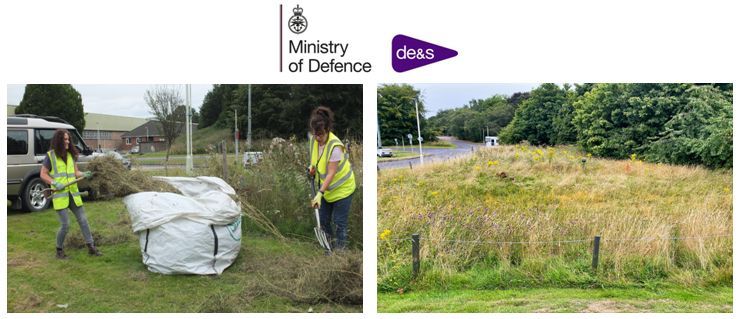
Pre-Covid News
The information below is, by and large, past history that might interest you.
GCHQ Cheltenham
Spring 2020 heralded the start of GCHQ working with us on the research of the red Mason bee. We are additionally looking at bespoke selected wild flower and garden species planting on the premises. This should be very exciting for all involved.

West Mercia Police
In an expansion of our research, new nests have been installed at Shrewsbury Police Station and Police Divisional Headquarters at Hindlip Hall, pictured below on the right, where there is already a very active colony of bees in the grounds.

The images below display the visually stunning grounds of Hindlip Hall, managed by Stuart Reading on the right. It's worth noting that the picture on the left is taken of one of the surrounding fields owned by the estate. Clearly there were some very forward thinking and my farming colleagues will notice that the headlands have been sown down to what is now a very mature wildflower meadow mix. It is abundantly obvious that the reason the bee colony is so strong at Hindlip is because all this soft landscaping and conservation work has been completed by Stuart and his team.

Thames Valley Police
On Wednesday, 7th April 2021 I had the pleasure of meeting Neil Wickham and Nigel Wigmore (below left) at Sulhamstead Thames Valley Police Training Centre where we put out a number of new bee nests across the estate relocated from Kidlington South Div. HQ (below right). We look forward to expanding this intiative out from TVP across the counties to other Police Stations.

February 2020: Her Majesty's Shropshire Emergency Services
Just before lockdown, we were able to disperse 1,000 bee pupae in Shropshire, spread geographically across the Shropshire Fire & Rescue Stations at Tweedale, Bishops Castle, Clun and Shrewsbury, plus Police Stations at Shrewsbury, Ludlow and Church Stretton, as well as The Royal Shrewsbury and Princess Royal hospitals.

Shrewsbury and Telford Hospitals (SaTH)
This is now the third season we have put out Mason bee nests at the Princess Royal Hospital and the Royal Shrewsbury Hospital. The image on the left is of Julia Clarke - Corporate Management Director, alongside one of our nests at the PRH where at the moment, we have very low breeding results of the bee. On the right is Trevor Hunt, Consultant Surgeon for the Trust, supporting our stand at Shrewsbury Flower Show 2016.
In due course we are planning to sow a bespoke wildflower meadow there for not only the bees but also for the pleasure of the patients and staff alike.
If you would like to learn more about this and other gardens we are renovating at the hospitals, please click on this link: https://www.youtube.com/watch?v=DsdSeO6qZAI

Telford Rotary Club Purple4Polio campaign at the Princess Royal Hospital
At 10am prompt on the 31st October 2017, in conjunction with the Telford Rotary Club’s Purple4Polio campaign to highlight this dreadful disease across other parts of the world, the students of Hadley Learning Community planted out 10,000 purple crocus corms. The purple colour represents the fact that when a child receives their polio drops, their little finger is painted with a purple dye so it is clear they have received their life saving vaccine.
And from the picture below, just see what has been created. There are four swathes of purple each spring to greet anyone who has cause to visit our hospital. This will help to alleviate any natural mood of anxiety for anyone visiting and ….. all those crocus flowers are loaded with nectar and pollen for my Mason bees, as they start to emerge from pupating over the winter period. A sort of one-stop food bar for them!

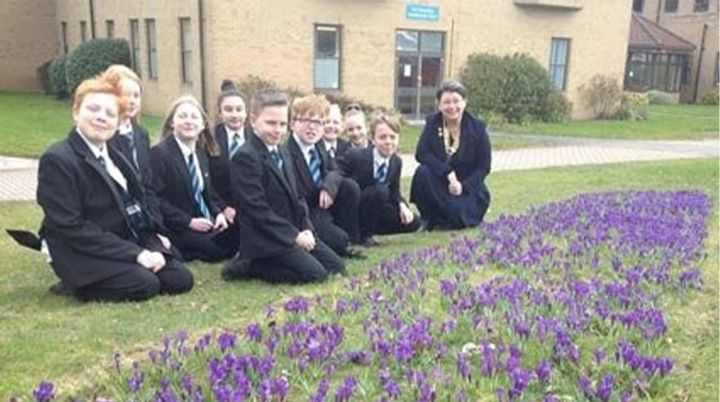
John Radcliffe Hospital, Oxford
As with the Police Stations, we have now started a new bee colony at the John Radcliffe Hospital with stock bred from the Royal Shrewsbury Hospital.

Southmead Hospital, Bristol
On 12th October, 2020, Viv visited Southmead Hospital in Bristol, where a new bee nest was installed. The image on the left below shows Esther and Jamie who are going to manage bee nest in the established wild flower meadow, right alongside their helipad.
This is a brand new hospital of stunning appearance, surrounded by soft landscaping to a very high standard. We look forward to seeing whether there are any red Mason bees on site and if not we will introduce a new colony in 2021 from stock at The Royal Shrewsbury Hospital.

Ministry of Defence
We are continuing to expand our research with the Ministry of Defence from Shropshire’s Donnington DE&S (Defence Equipment and Support) depot to the Nesscliff British Army Training Grounds in North Shropshire. Nesscliff’s unique property holds some stunning, totally untouched ancient riverside meadows. This year we have laid out five nests alongside the bordering River Severn and we can’t wait to see what sort of take up we get from this research, being monitored by Major Richard Slaney.

Defence Munitions Gosport
On Thursday morning, 11th July 2019, Raff Turk, the Conservation officer for DM Gosport, invited us for a tour around the vast high security site, set within pristine preserved grounds of diverse flora and fauna. As a result, Raff has demonstrated that it has been possible to start off his own colony of Red Mason bees with some of our bee nests.
2020 has seen expansion to further Defence Munition sites and the following now have a bee nest located around the UK: DM Beith, Crombie, Glen Douglas, Kineton, Long Town and Plymouth.

MoD Abbey Wood
On 5th June 2019, trustees Lee Sanderson and Viv Marsh attended the World Environment Day at MoD Abbey Wood in Bristol, the headquarters of all Services procurement. We received a warm welcome and great interest was shown by staff on our research programmes. As a result of our visit, there is now a bee nest installed, to the right of the premises below.

Defence Infrastructure Organisation (DIO) tour 22nd August 2019
The Defence Infrastructure Organisation (DIO) invited trustees Viv Marsh and Lee Sanderson down to Wiltshire for a tour to AOSB Westbury (left) and the Yorkshire Regiment at the Warminster Barracks (right). Empty bee nests were placed at these locations along with Westdown camp and the deserted village of Imber on the Salisbury Army Training Plains. Reports will be compiled in 2020 to see if there are any bees present on these sites.

DIO tour 9th & 10th December 2020
The Defence Infrastructure Organisation again invited Viv Marsh to UK NATO HQ Northwood, RAF Command High Wycombe and Army Land Forces HQ Andover for an assessment of bee habitat at these key HQ sites. As well as bee nest placements, it has been agreed to sow a new wildflower meadow at Andover and bee-friendly garden planting schemes at the other two sites in 2021. These will run in tandem with another wildflower meadow being sown at Whale Island, Portsmouth, HM Navy HQ, also in 2021.
Royal Military Academy Sandhurst
2018 has seen the start of a new bee colony bred from stock at RAF Shawbury, crossed with those of MoD Donnington and MoD Training grounds Nesscliff, kept under the watchful eye of Major James Keeley, MBE.

Britannia Royal Navy College, Dartmouth
The trustees of Praise Bee are extremely proud to announce that the Royal Navy at Britannia Royal Navy College in Dartmouth have now joined the research programme, where four empty bee nests have been placed within the forty acres of the grounds.
There is already an active colony of honey bees (apis mellifera) on site and it is anticipated that a new colony of Mason bees can be bred for ultimate dispersal to surrounding church yards.
The image on the left below shows Commander John Patterson, RN in discussion with Peter ‘Tansy’ Lee, Health & Environment Officer about the strategy. On the right is Peter Lee and Viv Marsh installing a nest in the grounds above the river Dart.

HMS Excellent
In the afternoon of 11th July, 2019 we had great pleasure visiting HMS Excellent on Whale Island in Portsmouth, hosted by the Conservation Officer, Ian Mackfall.
Due to Ian’s previous work on site establishing a range of wild flowers, he has successfully created a colony of Mason bees using our nest. This proves what can be achieved at other MOD sites across the UK.

Royal Air Force College Cranwell
(Below left) this research is supported by Deputy Commandant Group Captain Gordon Bettington and Tony Hird, Station Heath & Safety Advisor. Empty bee nests have now been deployed across the college, in the hope of breeding a new colony for dispersal under the diligent eye of Sergeant Lee Viner, who reports that bees are already on site.

Shawbury Village Glebelands Osmia Bee Meadows
The pictures below show on the left the main RAF Shawbury Mason bee breeding site, down in Sector A alongside hangar 17, where there is an abundance of wildflowers and grey Alder trees for the bees to feed off. On 18th April, 2019 we filmed with the British Forces Broadcasting Services. To view the latest breeding research at RAF Shawbury please click on this link: https://www.forces.net/news/services/raf/busy-bees-raf-shawburys-fight-save-bee-population.
Over the last 6 years we have successfully bred and transferred bees from the station to Shawbury Village Glebelands, over the road at St Mary’s church. This can be seen in greater detail with the Womens Institute members, further down this website.
In September 2018, to enhance and ultimately increase bee number productivity, we started trials undersowing the old grass ley with some 12 new selected wildflower species. This unique research necessitated mowing the old turf down to a lawn finish and then cultivating the surface with some spring tines for a decent tilth. The area was then strip sown and, with a couple of passes by Richard Bailey on his second Massey Ferguson 35 tractor pulling a ballast roller, the job was complete.
On the 9th of November, this work was inspected by Owen Paterson, former MP (top right).

RAF Brize Norton
2016 proved to be a massive success, with the breeding of 120 pupae from the original twenty given with the nest, pictured below left (with Lisa McLaughlin, Deputy Environmental Protection Officer). In 2017, we installed another nest alongside the aircraft refuelling tanker hangars (pictured below right). The success of this new colony establishment is testament to the close care by the Environmental Team and their sympathetically managed grounds with a plethora of primroses in addition to a forty acre SSSI meadow managed by Oxfordshire County Council, alongside the Brize Norton airbase.

RAF Halton

Her Majesty's Naval Base Gibraltar
In February 2019 a Mason bee survey was initiated with Joint Forces Command at HMNB Gibraltar in collaboration with the Gibraltar Alameda Botanic Gardens. The purpose of this exercise is to prove whether or not the red Mason bee does indeed live this far south in Europe. This will be the start of other selected European sites, allowing us to have a clear picture geographically of how widespread the collapse of this bee species is. Dr Rhian Guillem will be monitoring sample bee nests placed up on Windmill Hill at the south end of The Rock plus other sites at HMNB Gibraltar, including the War Graves Cemetery up by the frontier.
Pictured below left is Duncan Bell, Deputy Operations Manager (left) with SSgt Lee Wagner, Infrastructure Manager at HMNB Gibraltar.
Pictured below right is Dr Rhian Guillem (left) Technical Entomologist Officer of the Alameda Botanic Gardens with WO2 Steven Wood (right) British Forces Gibraltar.

Conclusion 07/10/2020. Results so far to date indicate that this species of bee (Osmia bicornis) does not, as previously stated, exist as far south as the straits of Gibraltar. After extensive trials of empty bee nest placements across The Rock and along the coastline of the Algarve through to Marbella in Spain, the estimated conclusion is that this bee only lives on a latitude line as far as mid to southern France. This is contrary to that of past expert opinion when perhaps the environment was a little friendlier to the insect habitat.
Natural England at Braunton Burrows, North Devon
2017 witnessed the start of a major bee breeding programme at Braunton Burrows, alongside the Royal Marines training base at Chivenor in North Devon.
Braunton Marsh, within the Burrows, is an SSSI designated area and is the UK’s largest natural sand dune conservation area, brimming with wildlife and wild flowers.
Accordingly, we have set out some eight empty bee nests in linhays (pictured below) last February and we are delighted to report that many have been colonised by the Red Mason bee. Just as soon as total bee pupae numbers have been recorded, we can then outline our plans for breeding this bee across Devon county.

The Environment Agency
On 27th August 2020, plans have been firmed up for us to work with the Environment Agency. We look forward to updating the news very shortly.

Praise Bee working with the Church of England
The Bishop of Shrewsbury, The Rt Revd Sarah Bullock (below left) has given us her blessing in helping to promote the church bee initiative.
Below right is the Rev. Michael Last who has accepted bees bred from St George's Church in Shrewsbury, now distributed, with the help of Hales W.I., around his his churches listed below:
St Peter's Adderley
Christ Church, Ash
Holy Trinity, Calverhall
St John the Baptist, Ightfield
St Margaret's, Moreton Say

Women's Institute Denman College, Oxfordshire
With bees bred by Shropshire WI last year, we have now established a new colony at WI Denman Teaching College and I suspect these with breed with bees already present on the campus.

The project is being overseen by Hales WI, pictured below and in September it is anticipated members will collect the full cardboard tubes out of each nest and bring them back to Shropshire County WI Headquarters for collection and distribution to further churches and county institutes.

The images below show some members of Shawbury WI at St Mary the Virgin Church in Shawbury, where there is now a new colony of Mason bees. Their numbers are set to increase once we have sown the new bee meadow on the church Glebe Land kindly supported by RAF Shawbury.
Additional bee colonies have also now been set up at the churches listed below:
St Bartholomew's, Moreton Corbet
St Andrew's, Stanton Upon Hine Heath
St Mary the Virgin, Astley

Locations of bee nests put out by Shropshire WIs
These two 2017 map pictures of Shropshire represent a seismic step forward in the Praise Bee Charity work. After years of planning, we are incredibly proud to demonstrate the collaboration of the Women’s Institute working with all denominations of Shropshire’s churches.
I hope you can see some 68 churches marked with a red square, each of which has had an empty bee nest placed and managed by the individual local Institute members.
Starting in September 2017, members are recovering any colonised inner cardboard tubes and taking them back to the WI County Office. We look forward to announcing in early spring 2018 how many bee pupae we have bred at each church and those that are deficient of bees will have new pupae introduced by March 2018.
Once we have established a proven template of success in Shropshire, further expansion afield into other counties can be considered. In the meantime, embryonic templates are being established in Oxfordshire, Buckinghamshire and Devon, with additional expansion being planned in the forthcoming years.

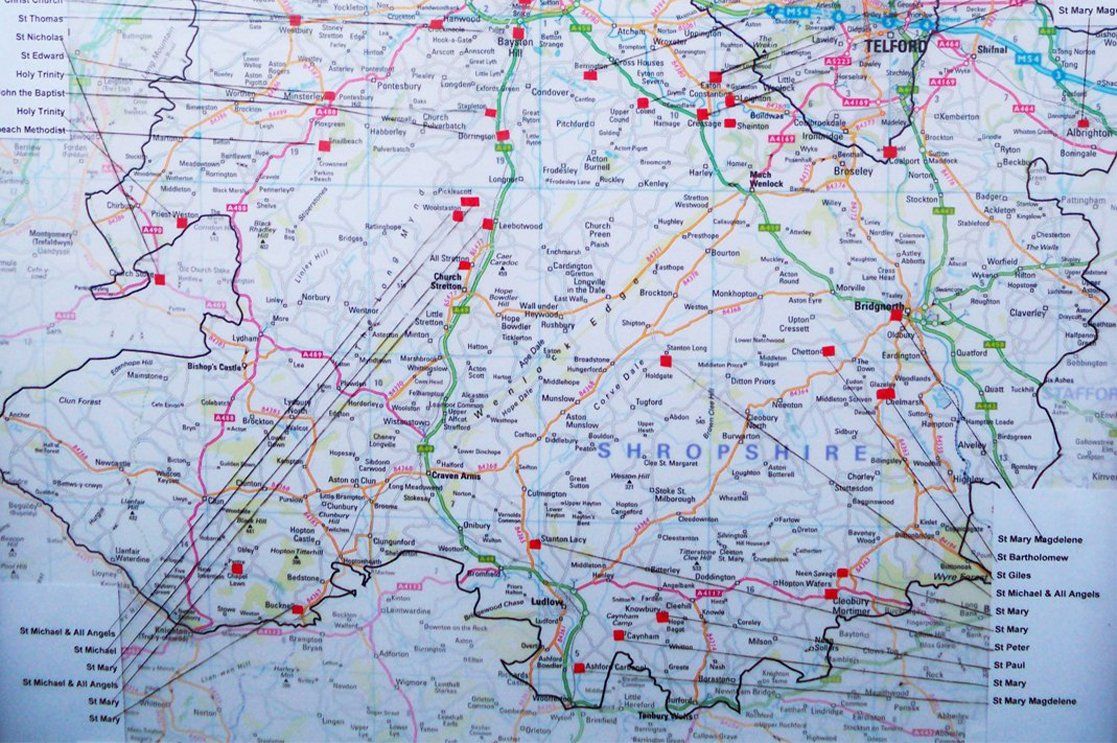
2017 Shropshire WI Bee Pupae Results
If you compare the results of what the Women's Institutes found with their parish churches shown on the chart below, it makes for interesting reading. The most obvious point you will immediately spot is that there are more churches displayed on the map above than what was recorded from the bee nests brought back to WI County Office. This is simply because there is nothing out there in those churches yet, so hereby is our 'Mission Statement':
To repopulate these 'bee vacant' churches with pupae that we have collected from these natural active colonies in the chart below.
As ever, nothing is straightforward in life, and it may well be that some of those 'vacant' churches will never be able to support a bee colony, due to the lack of flowers, pollen and nectar in the immediate surrounds. This can only be rectified by local gardeners growing more bee friendly species within the guidelines of the Royal Horticultural Society 'Perfect for Pollinators' campaign plus a number of other species I am researching in my nursery trial beds shown on this website.

This will take a number of years to achieve. It might also be of interest to have a look at some of the photographs to the right of this chart below. Anyone out there who can recognise and identify these interlopers?
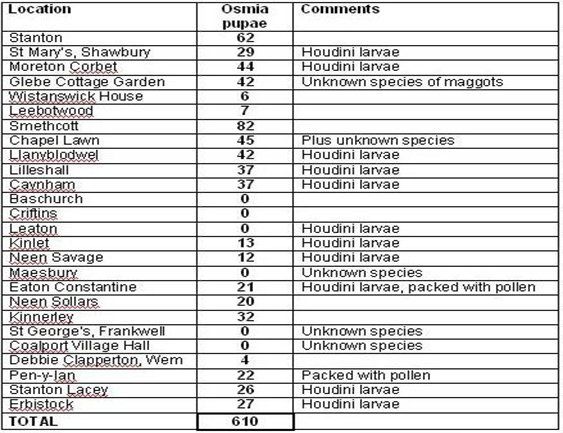

Our new Mason Bee research wildflower meadows at Harper Adams
Not surprisingly, since we had sown the two trial plots as Harper Adams, we have encountered predicted problems and this is indeed why we are doing these trials. The first plot (bottom left with the Land Rover) has shown poor wild flower establishment due to the difficulty in keeping the young plants alive within the growing grass sward. Allied to this, greater emphasis will now be placed on carefully timed subsequent mowing of that grass, to maintain the correct environment at ground level for these plants to flourish.
The second photograph (bottom right) of the piggery meadow shows a mass invasion of docks and nettles. To this end, I have recommended that this site is burnt off with Roundup and left fallow for the next two years so that we can rid the ground of these perennial weeds. I consider this to be a positive result, as it reflects what can happen out there "in the field" of a typical farm.

Solitary Bee (Osmia bicornis) Nest-Block Experiment at Harper Adams University
Professor Keith Walters (above left) reports:
Solitary bees are known to forage selectively on pollen from various flower species. Even when their favoured flowers are less numerous than others, adult bees seek them out to feed their larvae, but why they do this is not fully understood.
Building on both the results of experiments conducted by Praise Bee participants and their records of flower visitation in the field, Harper Adams University (HAU) is currently conducting research into the impact of different “pollen mixes” on the development of immature bees from egg laying to the emergence of adults. Using specially designed blocks with a nest cell sized cavity, a single egg (provided by Praise Bee) is isolated with one of several experimental pollen mixes. Over the next six months key life-history characteristics are being measured (under carefully controlled laboratory conditions mimicking those experienced during the typical UK autumn-spring period) to compare survival and relative developmental success of the immature stages of the bees when offered the different pollen mixes.
This work has been facilitated by the well-established collaboration between the HAU Research Group and the Praise Bee work Programme, and it will help determine why bees are so specific about which pollens they collect. In turn this will inform us about which groups of plant species will have the greatest impact for increasing numbers of solitary bees in areas where they are planted, and critically, why this is the case. The results of the work will be posted on the Praise Bee web site when it is completed.
Our new Mason Bee research wildflower meadow at Hunkington Nurseries, North Shropshire
2013 saw the nursery purchase of a completely overgrown 1.5 acre field, last farmed by myself in 1980 for grazing my sheep. Since those days, the grass meadow fell into complete neglect, with the crataegus hawthorn hedge growing out into the field, along with self-sown oak trees, brambles and ferns, as you can see from the picture below.
It has subsequently taken four years of mechanically removing this material, plus some 96 backbreaking knapsack applications of Roundup (glyphosate) herbicide to finally create a clear field for cultivation.
From the pictures below, taken in September 2017, you can see my improvised somewhat old fashioned methods of strip sowing some 36 wild flower species into the ground, with the help of my sister Ursula, using an antique aero seeder, similar to the one my Grandfather had at Church Farm, Beckbury back in the fifties. I then harrowed the ground down with my geriatric Landrover using a bent metal gate as all the drag harrows that I used from my farming days have been consigned to the scrap heap! I then finished off the seed bed with a final pass of the Cambridge roll as you can see.
The whole purpose of this venture is to create a primary seed source for the future green seeding of meadows across Shropshire, with the help of the NFU starting off with the RAF Shawbury supported meadow at the village Glebelands.

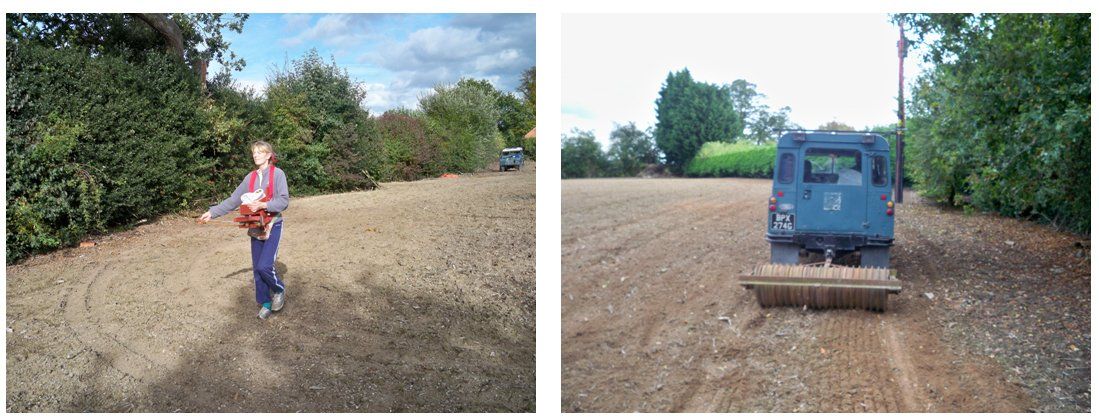
10th June 2018. Progress! As you can see, the grass has grown and some of the wild flowers are starting to emerge, like the corn cockle (agrostemma githago) below right. The art for the next couple of years will be to keep the grass sward short, so that all those dormant seeds that are lying in the ground will get more light to facilitate germination and growth.

HEY PRESTO!
After 3 years establishment of this new trials meadow ground here in the nursery, we are delighted to announce that we have been successful in establishing a wild flower sward. The picture below was taken in mid September 2020 and you can see, growing very well within the grass, some yellow meadow veitchling and some purple vetch. Prior to this date, this field was also displaying Ox eye daisy and additional species in full bloom. We look forward to replicating this result around other UK sites in 2021.
Additional meadow wildflowers present: Meadow Cranesbill, Birdsfoot Trefoil, Toadflax, Oxlip, Cowslip, Knapweed.
Hedgerow species present: Campions, Columbine, assorted Geraniums, Bluebells, Comfrey, Monkshood, Ragged Robin. Primroses,
Bare arable ground species present: Red Poppy, Corn Cockle, Yellow and White Charlock, Fumitory, Hawkbit, Wild Strawberry, Viper's Bugloss, Valerian, Marsh Marigold (on wet ground only).
Arable cropping present: Winter Oil Seed Rape.

Royal Horticultural Society
We are delighted to announce that the Royal Horticultural Society is now working with our research and has deployed three empty bee nests across Wisley Gardens to see what levels of population the estate currently supports. In time, it would be interesting to start analysing retrieved pollens from those nests to give us a greater understanding what is happening at garden level.
23/10/2020 RHS Wisley: After these bee nest placements in 2019, no recorded results have been found of this bee so far to date. Therefore, we will look to place new bee pupae in these nests in 2021, along with further investigations at all the other UK RHS gardens.

We are delighted to have been featured in the January 2021 issue of the RHS The Garden magazine, which you can read below.

Professor Simon Potts, University of Reading UK, Chair of the United Nations Global Pollinator Assessment
"High praise indeed must go to Praise Bee for the amazing diversity of activities helping our pollination heroes. From raising awareness, to providing nesting sites and bouquets of flowers, Viv Marsh and the Praise Bee team keep on making a difference. It is with great pleasure that I give my full support to them as they seek new partnerships and allies to help British bees thrive."

Footnote: Note the Mason bee on Simon's nose! This demonstrates just how friendly and harmless these bees are, and they really do make ideal pets in your garden once you have got a nest established. Because they don't make honey they have no need to sting to protect that food source.
Shropshire Farms Research sites
The picture on the left shows site at the bottom of my old farm at Hunkington, where the conditions are very boggy. Accordingly, I will now germinate some bog plants here at Hunkington Nurseries, to back plant into the ground next year.
Have a look at the two black and white shots taken in 1958, when we used helicopters to spray various crops on our farm. The images show a Hiller H-23 Raven helicopter - (for you aircraft buffs!) The helicopter is spraying a crop of ware potatoes to prevent blight and aphids. Even though the second image of the aircraft in flight is hard to see, I'm sure you can imagine just where all the spray is going, drifting across the hedgerows from the downdraft vortex of the rotating blades.
The field shown is actually right alongside the farmand with greater environmental awareness such spraying of chemicals from the air has now been banned. Thankfully, with modern technology and land-operated sprayers, spray drift is kept to the minimum which is good news for the bees. Hopefully, with a combination of these improved husbandry techniques, complete with my planting of the wildflowers within the reserve, a new wildlife haven can be created for future research.
How to identify the Mason bee (osmia bicornis)
Mason bees are not plasterer bees!
Plasterer bees (Colletes Daviesiana) are active between mid June and mid September. Sometimes they excavate soft mortar joints in brickwork but they also nest in existing holes that they find.
Mason bees (Osmia bicornis) nest in any convenient space they can find., e.g. pre-existing holes and old plant stems. They are called Mason bees because they build their nests using mud- they do not burrow into walls and cause damage. The adults are active from around April to July. They are known as the 'Red Mason bee' due to their dense ginger coloured body hairs.
The life cycle of osmia bicornis
From the chart below, you will see that Mason bees emerge around March or April - males first and then the females. Once they have mated the males die and the females go about the task of creating a nest to lay their eggs.
Life cycle chart courtesy of crownbees.com
When they have found a suitable site, the females plug the innermost end of the hole with mud. Then they tirelessly collect pollen, nectar and mud and lay a series of eggs in each 'compartment'.
Below you can see our observation tubes which show the pollen and nectar laid down to feed the larvae, with a mud partition between each egg.
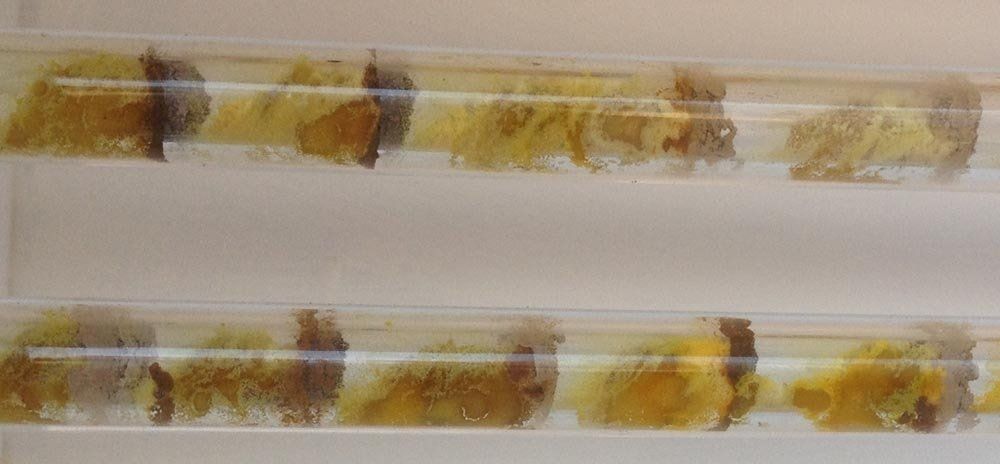
Around May to June the eggs hatch into larvae, which then start to feed on the pollen throughout the summer. It is important not to move the nest at this stage, otherwise the larvae might become detached from the pollen food source. If you do need to move the nest, do it very carefully and keep it horizontal. You can see the larvae feeding in the picture below.

When the larvae are fully grown, in about August or September, they spin a cocoon. The adult bees remain dormant in these cocoons until they emerge the next spring to begin the new cycle.

Predator Management - the importance of nest cleaning
In 2019, following a heavy strike by predators at both the MoD Nesscliff Training Grounds and RAF Shawbury, we were able to hatch out dormant eggs in the laboratory and discovered the presence of the Ruby-tailed Cuckoo Wasp as well as the Houdini fly. We still feel that other predators are present so these investigations will continue for the next few years.
As an adult fly, the female loiters around the bee nest waiting for the female bee to depart for a foraging trip. It then quickly darts in and lays its eggs, which hatch before the bee eggs and in consequence the fly maggots then eat all the nectar and pollen before the osmia have hatched. It is known as a kleptoparasite because it steals the food that was provided for the osmia larvae, which in turn causes the hatching bee larvae to starve to death.
These cacoxenus indagator grubs below were found in some of the nests that we cleaned out. If we had not removed them they would have eaten the food intended for the growing Mason bee larvae. At the top of the picture is a ball of mud from the tube to give you an idea of how small the grubs are.

Providing a home for the Mason bee
Some people tell us that they have had Mason bees in their gardens but they "don't survive the winter". In actual fact, this is probably nothing to do with the winter - it is more likely that they have fallen victim of the Houdini Fly. In order to stop this parasite taking all of the pollen and nectar you will need to manage the nest.
Although Mason bees will happily live in holes drilled in wood or old canes, you cannot protect the larvae this way as they cannot be opened up and cleaned without damaging the bee larvae. The photo below shows how bees have made their nests in sleepers at Sale Farm. Although they will overwinter well in this location this will not protect them from their natural predators. Note the holes that have already been filled up are plugged with mud.
We are currently trialling a nest that can be dismantled and cleaned . If these are successful we hope to work with a charity to manufacture nests of this design, suitable for your garden. If you are handy with DIY you might like to try to make something similar, but on a smaller scale for use in your garden. It's on a similar design to a flower press, with several layers of wood stacked on top of each other and with grooves on each matching side to make holes for the bees to nest in.
This nest box is approximately 7" long, 6" wide and 3" tall. The optimum tube length of 7 inches allows the female to lay the full complement of both male and female eggs. The holes are slightly larger than 1/4" in diameter. However, next year we will be trialling with tubes of varying diameters and we will update the website with our findings.
Whatever design of bee nest you choose, it needs to be sited facing south west, where it is in full sun for most of the day and you must be able to open it up to clean out any potential predators.
Bee houses and bee tubes are also commercially available. If you decide to purchase these, please ensure that they have a paper liner in the tube that can be removed. You should carefully unroll and clean out the paper tubes in the autumn, as in the picture below. The cocoons should be removed and kept in a cool dry place for the winter before releasing them into your garden in the spring, when the weather starts to warm up.
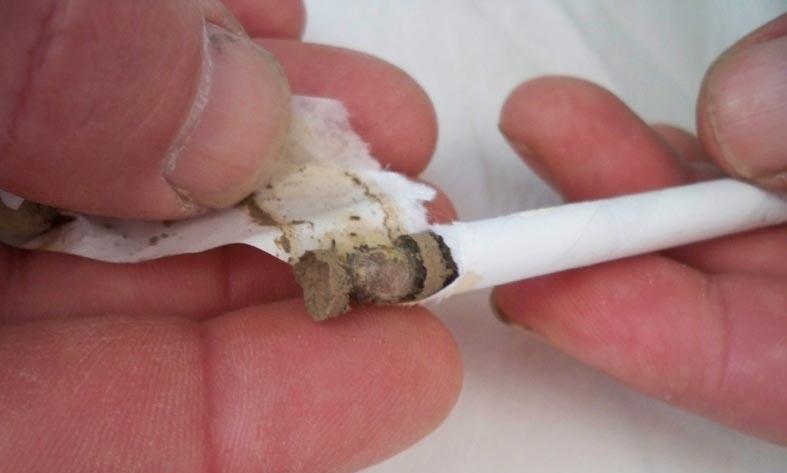
If you click on the link below you can see all this action of harvesting the bee tubes in greater detail.
How you can help
If you are a gardener or a farmer ... consider growing as many pollen and nectar rich flowers as possible for all bee species.
If you are interested in conservation ... consider joining the county wildlife trusts, like the one here in Shropshire.
Want to find out more?
Below is a short video showing one of my Osmia bicornis that had just emerged in spring


